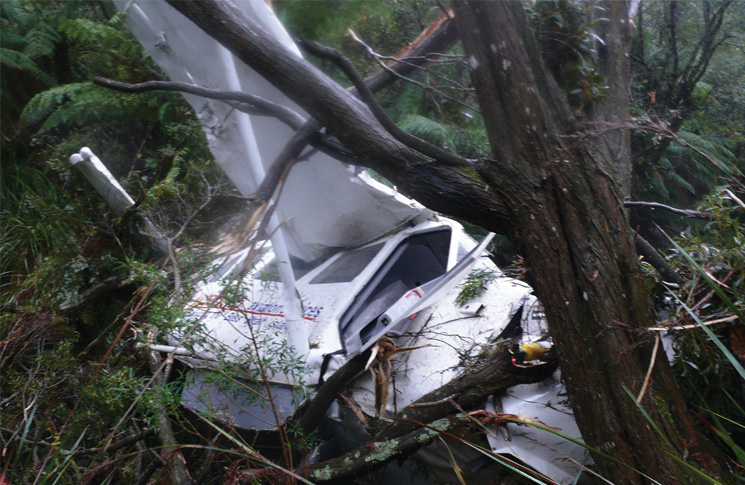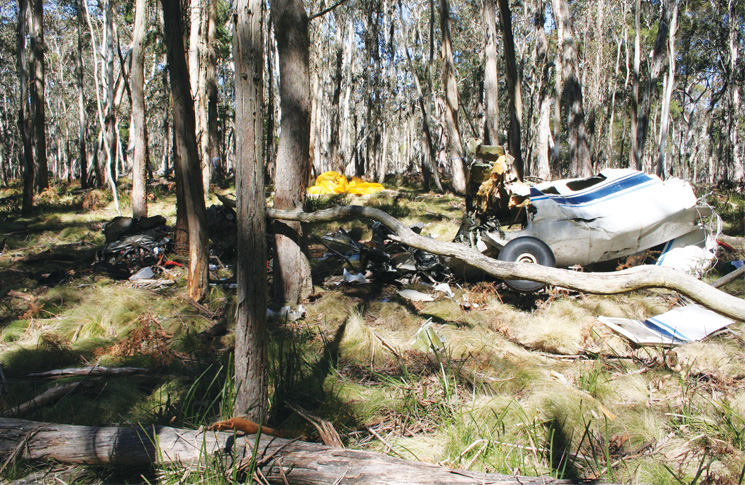VFR pilots should make early decisions to avoid the danger of unintentionally flying into cloud.
A total of 101 occurrences of VFR pilots inadvertently flying into instrument meteorological conditions (IMC) in Australian airspace were reported to the Australian Transport Safety Bureau (ATSB) in the decade from July 2009 to June 2019. Of those, nine were accidents resulting in 21 deaths.
‘These concerning figures taken from the ATSB’s National Aviation Occurrence Database show that almost one in 10 “VFR into IMC” occurrences resulted in fatal accidents,’ ATSB Chief Commissioner Greg Hood says.
‘Weather-related general aviation accidents remain one of the bureau’s most significant causes for concern in aviation safety. The often fatal outcomes of these accidents are all the more tragic because they are almost always avoidable.’
To remind VFR pilots of the dangers of flying into IMC and highlight the actions they can take to avoid a weather-related accident, the bureau has launched a safety promotion campaign titled, ‘Don’t push it, DON’T GO—know your limits before flight’.
The campaign highlights three key messages:
- the importance of doing thorough pre-flight planning and having alternate plans
- pressing on where there is the possibility of entering IMC carries a significant risk of spatial disorientation
- the value of using a ‘personal minimums’ checklist to help manage flight risks.
Flying into poor weather without the training and experience to do so can rapidly lead to spatial disorientation when the pilot cannot see the horizon.
‘The brain receives conflicting or ambiguous information from the sensory systems, resulting in a state of confusion that can rapidly lead to incorrect control inputs and a resultant loss of control of the aircraft,’ ATSB Director Transport Safety Dr Stuart Godley says.
For pilots who fly under VFR, conducting thorough pre-flight planning and working to a personal minimums checklist aids sound decision-making both prior to take-off and during flight when faced with marginal weather or darkness.
‘Pilots without a current instrument rating should always be prepared to amend and delay plans to fly due to poor or deteriorating weather conditions, and not to push on,’ Godley says.
‘Have alternate plans in case of unexpected changes in weather, and make timely decisions to turn back, divert or hold in an area of good weather. Further, setting expectations for your passengers beforehand can take the pressure off continuing with the flight if the conditions exceed your personal minimums.’
Developing a personal minimums checklist is an effective defence against what pilots often term ‘push-on-itis’ or ‘get-home-itis’, Godley says.
A personal minimums checklist is an individual pilot’s own set of rules and criteria for deciding if and under what conditions to fly or to continue flying based on their knowledge, skills and experience. As a personal ‘go/no go’ checklist, it can help take the stress out of difficult decisions both before and during flight, acting as a safety buffer between the demands of the situation and the extent of a pilot’s skill.
‘Discuss your personal minimums with an instructor or a more experienced pilot,’ Godley says. ‘Have the discipline to stick to your personal minimums in spite of external pressures. And treat your personal minimums as a line in the sand over which you would not cross.’
If VFR pilots do find themselves in marginal weather, and are becoming disorientated or lost, they should seek whatever assistance is available.
‘In particular, air traffic control services may be able to provide assistance, including radar vectoring away from bad weather if the aircraft is in an area of surveillance coverage,’ Godley says. ‘There have been a number of reported occurrences where this simple action has averted potential disaster.’
The following case studies of investigations into aircraft accidents where a VFR pilot flew into IMC are excerpts from the ATSB’s updated Accidents involving pilots in Instrument Meteorological Conditions publication. They make for sobering reading, but are also opportunities to learn from the experiences of others.

Into the void
In November 2007, the pilot of a Cessna 337 Skymaster was conducting a private VFR flight from Moorabbin Airport, Victoria, to Merimbula, NSW. The pilot, who was only qualified to operate in VMC, had indicated the flight would track along the coast at low level.
The forecast weather included isolated showers or thunderstorms and low cloud over the sea and exposed coast. The low cloud was expected to be broken stratus between 800 and
2000 feet. Visibility was quoted as reducing to 3 km in thunderstorms with rain, and 6 km in showers of rain.
About 30 minutes after departing Moorabbin, people on a beach south-east of Venus Bay heard and suddenly saw the aircraft emerge from fog at low level, flying above the waterline on the beach with the wings level. Within seconds, the Skymaster turned right at a steep angle of bank while maintaining height and headed out to sea before disappearing from sight into the fog. Witnesses reported no apparent problem with the engines and the aircraft appeared to be under control. About two seconds after the aircraft disappeared from view, they heard a ‘bang’ and then silence.
Two days later, the aircraft wreckage and three of the deceased occupants were found washed up on the beach. The pilot was not found.
The investigation concluded that while manoeuvring over water at low level in conditions of reduced visibility, the pilot probably became spatially disorientated and inadvertently descended into the water.
By turning away from the land in the foggy conditions, the pilot would have encountered a featureless, grey environment with no visible horizon, making it extremely difficult to judge the aircraft’s attitude and/or height.
Lessons learnt
As a pilot you should accept that flying under VFR will not always enable you to reach your planned destination. Weather often does not act as the forecast predicts. You must have alternatives available and you must be prepared to use them—even if it means returning to your departure point.
In forecast marginal weather, careful pre-flight planning is essential and must include a thorough analysis of the latest weather forecasts and consideration of your available options. Those options should be evaluated while en route to ensure you have an alternative course of action available which provides for a safe landing.
Hazardous landing
In October 2010, the pilot of a Gippsland Aeronautics GA-8 Airvan was conducting a charter flight from Lady Barron Aerodrome, Flinders Island, Tasmania. The forecast weather was marginal for flight under VFR, with broken cloud forecast down to 500 feet above mean sea level in the area. However, the pilot’s assessment from the ground was that the cloud base was 1000 to 1500 feet.
During the climb after take-off, the weather conditions deteriorated to below those necessary for flight under VFR. The pilot, concerned about adhering to an unwritten operator rule to maintain a minimum height of 1000 feet, continued to climb into IMC instead of remaining visual below the cloud and lost all visual reference with the ground and horizon.
The pilot, who was not qualified to fly in IMC, continued to fly in IMC for several minutes in the hope of climbing above the cloud. When this did not happen, the pilot decided to turn the aircraft back towards Lady Barron Aerodrome, initiating a gentle turn to the right. The pilot succeeded in maintaining controlled flight with reference to the aircraft’s flight instruments. While intending to turn through 180 degrees, the pilot inadvertently turned less than this and flew towards high ground in the Strzelecki National Park.
Becoming visual, the pilot turned the aircraft into a valley unable to turn around nor out-climb. The pilot elected to conduct a forced landing into the treetops, slowing the aircraft to land at the slowest speed possible. Luckily, only one passenger sustained minor injuries and the pilot and other five passengers were uninjured.
Lessons learnt
If you encounter deteriorating weather, turn back or divert before you are caught in cloud. For a non-instrument rated pilot, even with basic attitude instrument flying proficiency, maintaining control of an aircraft in IMC by reference to the primary flight instruments alone entails a very high workload that can result in narrowing of attention and loss of situational awareness.
Hostile environment
In September 2008, a Cessna 206 departed Bankstown, NSW, on a private flight to Archerfield, Queensland, via Scone, NSW. The private pilot had purchased the aircraft on the morning of the accident flight and was advised the flight should track along the coast to Archerfield to avoid any weather problems. However, the pilot indicated an intent to visit friends in Scone.
The aircraft landed at Scone Airport and was met by friends of the pilot, who observed the subsequent take-off, in what was described by another pilot as ‘poor weather’. The aircraft was reported missing when it did not arrive at its planned destination. The following day, the wreckage of the aircraft was located on top of a ridge in rugged terrain, approximately 56 km north-north-east of Scone Airport.
The pilot and his two passengers were fatally injured.
The investigation concluded the pilot was probably attempting to return to Scone after encountering weather unsuitable for flight under VFR, and the circumstances of the accident were consistent with controlled flight into terrain after encountering IMC.
It was determined that both the forecast and actual weather conditions were not suitable for VFR flight on the planned route, with low cloud, rain showers and high winds. The pilot most probably did not check the forecast weather before the flight. The route chosen for the flight was not suitable for the aircraft in the prevailing weather conditions.
Lessons learnt
Although the pilot would have been generally aware of the weather situation from observations during the flight from Bankstown, and at Scone itself, without knowledge of the forecast weather on the route selected it is unlikely that adequate consideration was given to the risks inherent in continuing the flight.
Attempting continued VFR flight when the weather clearly does not support it compromises the safety of yourself and your passengers. Running out of altitude and/or visibility leaves you without alternatives.
Know your limits before flight
The ATSB encourages all pilots, no matter what their experience level, to develop the knowledge and skills required to avoid unintentional operations in IMC.
‘Our message is clear, “Don’t push it”,’ Hood says. ‘Have alternate plans in case of unexpected changes in weather, and make timely decisions to turn back, divert or hold in an area of good weather. The use of a “personal minimums” checklist can also be a strong mitigator against the risk of flying into bad weather. Checklists can help pilots more clearly identify risk factors.’
*This article was contributed by the Australian Transport Safety Bureau.
Read Accidents involving Visual Flight Rules pilots in Instrument Meteorological Conditions on the ATSB website: https://www.atsb.gov.au/publications/2019/avoidable-accidents-4-vfr-into-imc/



Comments are closed.